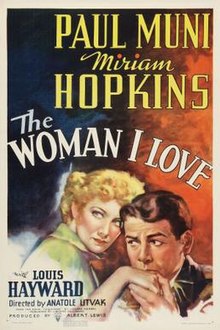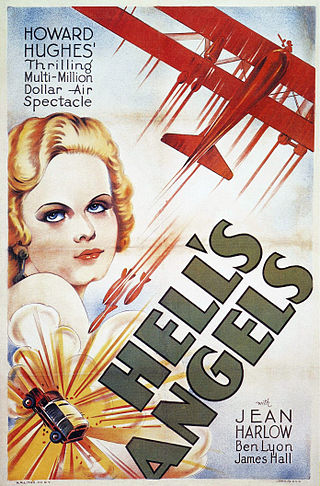
Hell's Angels is a 1930 American pre-Code independent epic war film directed and produced by Howard Hughes and director of dialogue James Whale. Written by Harry Behn and Howard Estabrook and starring Ben Lyon, James Hall and Jean Harlow, it was released through United Artists. It follows two dissimilar brothers, both members of the British Royal Flying Corps during the First World War.

Louis Charles Hayward was a South African-born, British-American actor.

Anatoly Mikhailovich LitvakOBE ; 10 May 1902 – 15 December 1974), better known as Anatole Litvak, was a of Ashkenazi Jewish origin American filmmaker who wrote, directed, and produced films in various countries and languages. He began his theatrical training at age 13 in St. Petersburg, Russian Empire.

Flying Leathernecks is a 1951 American Technicolor action war film directed by Nicholas Ray, produced by Edmund Grainger, and starring John Wayne and Robert Ryan. The movie details the exploits and personal battles of United States Marine Corps aviators during World War II. Marines have long had the nickname "leatherneck", hence the title.
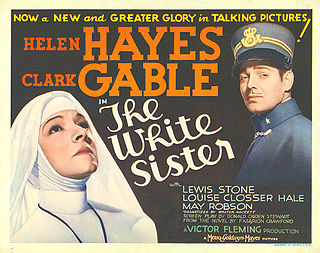
The White Sister is a 1933 American pre-Code romantic drama film directed by Victor Fleming and starring Helen Hayes and Clark Gable. It was based on the 1909 play of the same name by Francis Marion Crawford and Walter C. Hackett. It was a remake of the silent film The White Sister (1923).

Body and Soul (1931) is an American Pre-Code action drama film directed by Alfred Santell and starring Charles Farrell, Elissa Landi, Humphrey Bogart, and Myrna Loy. The story, adapted from the stage play Squadrons by Elliott White Springs and A.E. Thomas, depicts Royal Air Force pilots in World War I.

The Deep Blue Sea is a 1955 British drama film directed by Anatole Litvak, starring Vivien Leigh and Kenneth More, and produced by London Films and released by Twentieth Century Fox. The picture was based on the 1952 play of the same name by Terence Rattigan.

Le Bouchera.k.a.The Butcher is a 1970 French psychological thriller film written and directed by Claude Chabrol and starring Stéphane Audran and Jean Yanne. Set in the village of Trémolat, it tells the story of butcher Popaul who falls in love with Hélène, the head teacher of the school, while a murder spree is taking place in the area.

This Above All is a 1942 American romance film directed by Anatole Litvak and starring Tyrone Power and Joan Fontaine as a couple from different social classes who fall in love in wartime England. The supporting cast features Thomas Mitchell, Nigel Bruce, and Gladys Cooper. Set in World War II, the film is adapted from Eric Knight's 1941 novel of the same name.
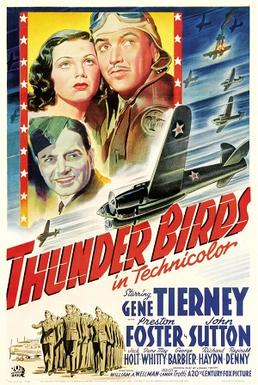
Thunder Birds is a 1942 Technicolor film directed by William A. Wellman and starring Gene Tierney, Preston Foster, and John Sutton. It features aerial photography and location filming at an actual Arizona training base of the United States Army Air Forces named Thunderbird Field No. 1 during World War II.

Dive Bomber is a 1941 American aviation drama film directed by Michael Curtiz, and starring Errol Flynn, Fred MacMurray and Alexis Smith. It was produced and distributed by Warner Brothers. The film is notable for both its Technicolor photography of pre-World War II United States Navy aircraft and as a historical document of the U.S. in 1941. This includes the aircraft carrier USS Enterprise, one of the best-known U.S. warships of World War II.

I Wanted Wings is a 1941 American drama film directed by Mitchell Leisen and based on a book by Lieutenant Beirne Lay Jr. The film stars Ray Milland and William Holden. The supporting cast includes Wayne Morris, Brian Donlevy, Constance Moore and Veronica Lake. I Wanted Wings features Lake's first major film role. Her career took off shortly thereafter; the same year, she starred in Sullivan's Travels. Lake would become one of the most popular and successful actresses of the early 1940s.

The Paris Waltz is a 1950 French-Italian historical musical film directed by Marcel Achard and starring Yvonne Printemps, Pierre Fresnay and Jacques Charon. It portrays the life of the nineteenth century composer Jacques Offenbach.
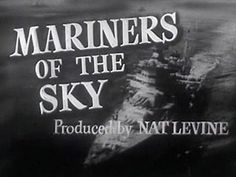
Mariners of the Sky is a 1936 American comedy-drama film directed and produced by Nate Watt, in his directorial debut. The film stars William Gargan, Claire Dodd and Douglas Fowley. Filmed with the cooperation of the U.S. Navy, it was a mild recruiting film in an era when the United States military was gearing up for a future war.

Flight Command is a 1940 American U.S. Navy film from MGM, produced by Frank Borzage and directed by J. Walter Ruben and Frank Borzage (uncredited), starring Robert Taylor, Ruth Hussey, and Walter Pidgeon. It has the distinction of often being credited as the first Hollywood film glorifying the American military to be released after the outbreak of World War II in Europe, a year before the U.S. entered the conflict.

The Blood of Others is a 1984 drama film directed by Claude Chabrol. It is based on the 1945 novel The Blood of Others by Simone de Beauvoir. The film was originally made as a three-hour English-language television film which debuted on August 25, 1984 on HBO. The film was then edited down by 40 minutes and dubbed into French for a European theatrical release.

International Squadron is a 1941 American war film directed by Lewis Seiler and Lothar Mendes that starred Ronald Reagan, Olympe Bradna and in his final film, James Stephenson. The film is based on the Eagle Squadrons, American pilots who volunteered to fly for the Royal Air Force during World War II. International Squadron featured noted Hollywood pilot Paul Mantz who acted as the film's aerial coordinator and flew during the production.

Young Eagles is a 1930 American pre-Code romantic drama film directed by William A. Wellman for Paramount Pictures. It stars Charles "Buddy" Rogers, Jean Arthur, and Paul Lukas. The story is based on the stories "The One Who Was Clever" and "Sky-High", written by American aviator and war hero Elliott White Springs. The film's hero is a "heroic combat aviator of the Lafayette Escadrille".

The Crew is a 1935 French war drama film directed by Anatole Litvak and starring Annabella, Charles Vanel, Jean Murat and Jean-Pierre Aumont. It was shot at the Joinville Studios in Paris and on location at an airfield in Mourmelon-le-Petit. The film's sets were designed by the art directors Lucien Aguettand and Lucien Carré. It is also known by the alternative title Flight Into Darkness.
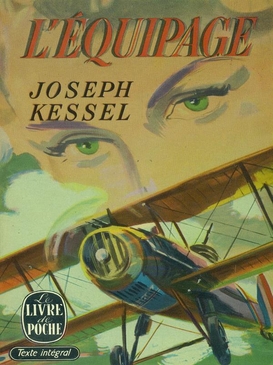
The Crew is a 1923 war novel by the French writer Joseph Kessel. It is set during the First World War, focusing on the crew of a two-man reconnaissance plane whose pilot is in love with the wife of the observer. It was bestseller and later secured Kessel membership of the Académie Française.
